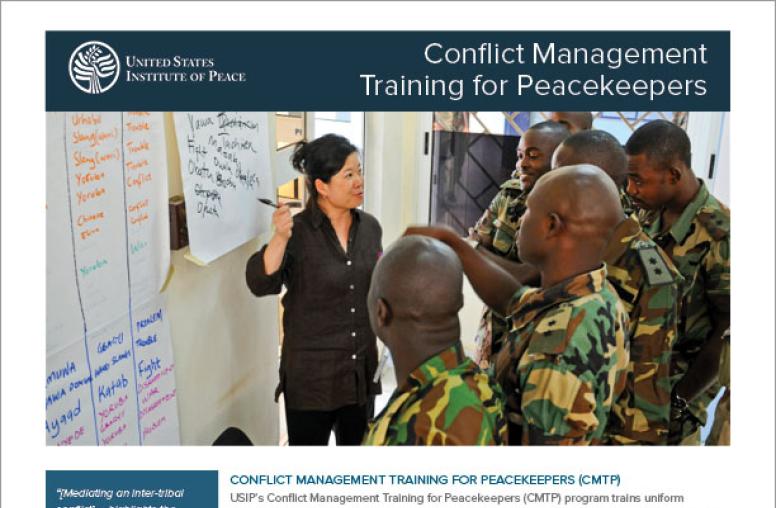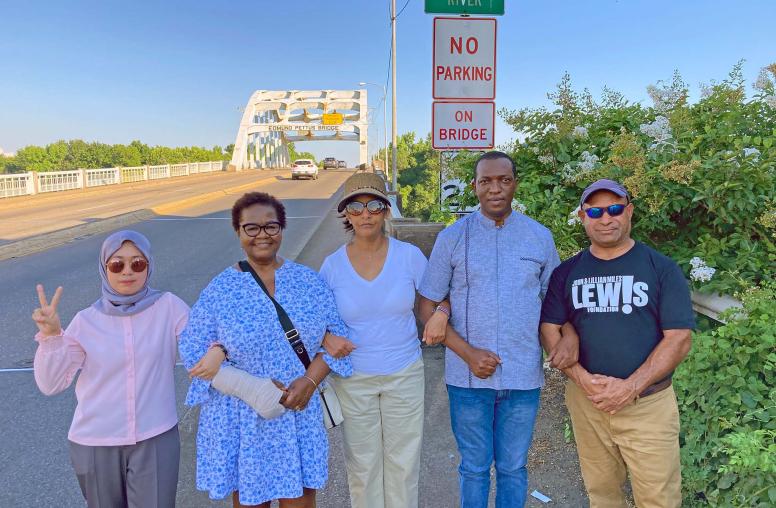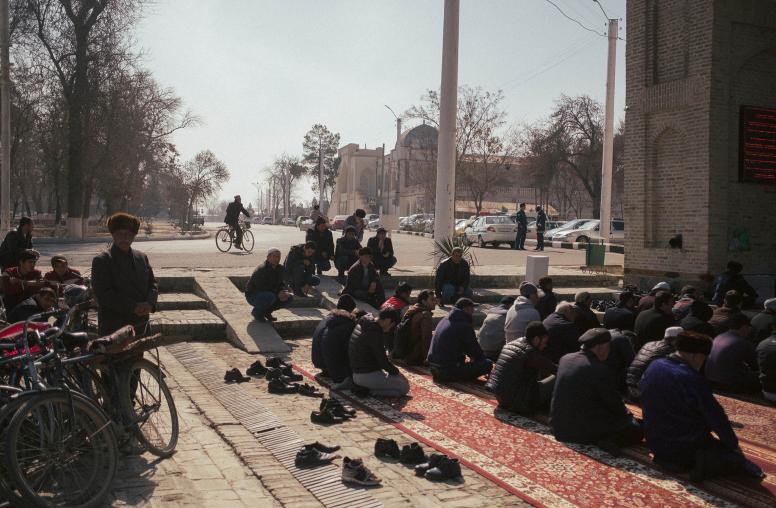Teaching Peace: Nelson Mandela’s Story in a World of Conflicts
A Georgia teacher on histories that help students find their own roles in building peace.
A world reeling from the brutal horrors of our current wars will next week mark (or perhaps overlook) the 10th anniversary of the death of a peacemaking icon: South Africa’s liberation leader and former president, Nelson Mandela. Amid continued or escalated wars — Israel-Gaza, Ukraine-Russia, Sudan, Yemen, Afghanistan and others — USIP this month hosted Georgia’s senator, the Reverend Raphael Warnock, in a discussion of Mandela’s legacy and immediate relevance. Another Georgian, Decatur High School history teacher Kristen Embry, introduced Warnock. She spoke about Mandela and her own mission of teaching history and peacebuilding to American students in the 2020s.

The metrics of our world’s current violence show starkly our need to learn from peacebuilders: Nelson Mandela, Mahatma Gandhi, Dr. Martin Luther King, Jr., or countless less famous people, from military veterans to diplomats to grassroots civic activists. After years of declining global violence, the world has faced steady increases in bloodshed since 2019, according to the Global Peace Index. Russia’s assault on Ukraine accelerated the increase last year and eight weeks of agony in Israel and Gaza have done so again. In July, global incidents of political violence had risen 27% beyond those in the 12 months ending a year earlier, according to the ACLED database project.
Mandela, whose struggle and global prominence were greatest in the late 20th century, remains relevant to young activists leading the 21st-century movements for justice and peace that can reverse those rising tides of violence. “Nelson Mandela’s story is a way to show kids in an Atlanta suburb, or in any city or town, that our struggles for a fairer, more peaceful world are universal,” Embry said.
A Teacher’s Story
USIP pursues its mandate from Congress and the American people to bolster our nation’s capacity to build peace, through its hands-on support for local peace initiatives in conflict zones abroad, and via education — through schools nationwide and its own Gandhi-King Global Academy. Embry is this year one of 22 teachers in middle and high schools nationwide whom USIP supports in educating young Americans about the causes of violent conflicts abroad and the paths to resolving them.
In the Georgia city of Decatur, Embry has taught world history for 20 years, leading youth through programs such as the International Baccalaureate and the Model United Nations. A grassroots, nonprofit civic group, the Decatur Education Foundation, has honored her as an outstanding teacher — and her students have publicly cited her effectiveness. This week, she spoke to USIP about her mission.
What was your path to becoming a professional teacher? And how did you choose to specialize in world history? What makes that feel important?
Embry: I grew up in the metro Atlanta area. As a kid, I loved history, but I thought I might explore it more like Indiana Jones than as a teacher. Still, I was doing things, like tutoring younger kids after school, that were really teaching. I thought about studying history or archaeology in graduate school, but I also needed a job and I tried a teaching position. I loved the kids; they gave me hope — and they still do! And I loved my work and never looked back. Now I’ve been teaching locally, in my own community, for 20 years. I thought about working my way up through the educational system, maybe to teach teachers. But the more time I spent in meetings, the more I realized that the classroom, with the kids, is where I still want to be.
I think we can’t overstate the importance of teaching our kids to dig for the evidence and think for themselves about human history. Look, we all, as human beings, share basics in life, right? We all feel love and pain, we all have dreams. But you and I need the humility to remember that we are each one person among 8 billion on this Earth. That means the personal view of the world that each of us builds from our individual life experience is a tiny molecule of the overall human condition. So as this tiny molecule of humanity, how do you or I expand our individual minds and hearts to comprehend our global human reality? We can do it only with an honest, open-minded examination of the histories of our many different tribes, communities and nations. That honest examination is hard work. Often, it forces us painfully to shed some cherished ideas that turn out to be comforting mythologies rather than histories grounded in research and evidence.
The polarizations, extremisms and wars that we’ve seen rising in recent years are generally collisions between the cherished mythologies of different groups. Achieving peace in any of our societies must begin with that honest historical inquiry, grounded in evidence. Only that can enable the calm, respectful discussions that we seek in the classroom — and that are essential as well in our governing bodies — to reach real mutual understanding and peace. How can any educational mission with our kids be more important than this?
You’re spending this year as part of USIP’s Peace Teachers program. How did you connect with this project?
Embry: For years, I’ve worked with education programs and clubs that take our kids beyond the typical classroom — such as the Model United Nations program and Close Up, which offers civic education in class visits to Washington. Through Close Up, I had the chance to visit and learn about USIP. And I’ve been using USIP educational materials in my classes.
This year I saw an opportunity to join the Peace Teachers program with about 20 extraordinary colleagues who are helping our kids to see the reasons for violence and extremism and find their own paths to helping build peace in their communities and in the world that they will inherit. As this group of educators trained and learned together this past summer, I heard us agreeing that we need to broaden our definition of what it means to teach peace and reconciliation in American schools. That is, we need this to be not just an academic topic that we present in the classroom, but a practice that teachers and students apply in our daily lives, within the school and beyond it.
So how do you find students responding to the ideas that peace education offers — and specifically to the story of Nelson Mandela?
Embry: For many of my kids, our conversations about world events can be heavy and dark. The idea that there are practical ways to build peace, and that students themselves can do it, offers them a sense of hope. It excites them to see that a more peaceful world depends not only on governments and huge forces that are distant from them, but rather that we all can have impact ourselves. Like so many of us, when the kids learn about the histories of other groups, that new awareness can be discomfiting and difficult. But awareness of others’ stories also breeds compassion for those people. Students are then eager to see that there are solutions to those differences — solutions that they can build even in their teens, as people who are about to become voters and start taking adult roles in the world.
And look, let’s be honest here. All of us — all teachers, all mentors of kids — need to make this available not just to the kids who will get the honors at graduation and be rightly celebrated as they head off to college. In many ways, it’s more important to connect with the kids who don’t give a damn about school, who would rather be anywhere but in a classroom — and who may feel that way because they are struggling just to survive. Maybe even to survive homelessness or addictions or depression. The day after I got home from this exhilarating trip to Washington, I was sitting with a kid in immense pain, working through my suicide prevention protocol with them.
For the struggling kids, as for the high fliers, my job is to teach a curriculum shaped by our community, meaning the State of Georgia. But more than that, my mission is to give my students the power of knowing that they each have something to offer to this human tapestry of which they’re a part. Each student should see that people in Africa, India, the Middle East or the city of Atlanta are facing many challenges that are the same as that student is experiencing. Students should understand that it matters that they think through what they feel is right, and that they act to build a better world.
And that sense of connection to this full ocean of humanity — to peoples and histories that they have barely imagined — that’s where Nelson Mandela or Gandhi can seize these kids. The story of Mandela — a young Black man living under unbelievable oppression who becomes a lawyer, a struggler for his people’s liberation, who spends 27 years in prison, and who comes out to shake the prison guards’ hands and build reconciliation and justice that saves lives — that tells students that the human struggle is universal. It’s not just an Atlanta thing or a Georgia thing. And if we look honestly at our hurting, bleeding world right now, tell me: What is more important than that?




